SELECTING AN AIRCRAFT TO BUILD………………
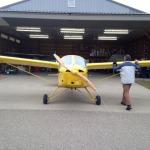
There are a number of airplane designs that are available for the potential builder. Nostalgia often dictates a biplane and there are a number of good designs out there. The two place bi-planes usually cost a lot and take a lot of time to build. The little single seaters can be tricky to handle but are highly agile. A number of fast two-place, cross-country designs are also available. They are usually more sophisticated and loaded with radios, instruments, etc. and they do their job well. They often require more runway, and more skill to fly. There are also the super simple and in-expensive aircraft, but they sometimes have disappointing performance. For many people, there are the more exotic, more modern type designs which hold out much promise for the entire aircraft industry, but every design represents a combination of compromises. A good example of this is the amphibians available, for with their larger engines and slower cruise, they gain the very attractive access to water recreation!
Each design fulfills a certain set of distinct requirements. In our opinion there has been a need for a good flying, light utility-trainer of conventional construction, with an economical engine. The Cygnet fills this need and compliments the selection of designs available to the amateur airplane builder.
We strongly urge the prospective builder to carefully evaluate the various designs that interest them. All too often the builder finds that the finished product does not meet their needs. More careful initial inquiring could have saved him a lot of work and expense. If at all possible, talk with those familiar with the airplane you are interested in, or better yet, fly in one. All of the many people who have seen the Cygnet at Oshkosh, (the EAAers Mecca) were very impressed with its performance. Dick Vangrunsven, the RV-3 designer, and Molt Taylor, the Coot and Mini-IMP designer, both flew the Cygnet at Oshkosh and had very favorable comments. Steve Wittman has flown the design, and his logbook comment was “A delightful plane”! The airplane was flown from Minnesota to Georgia and back with (of course) 2 people, one 6’3″ and 170 lbs., the other 6′ and 220 lbs. with no problems. One day they even flew 11 1/2 hours!
VISIBILTY AND FORWARD SWEPT SHOULDER WING………….
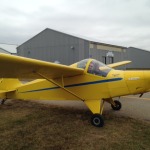
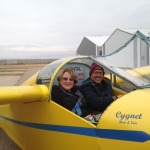
The wing location and configuration are responsible for the design’s excellent visibility. With the wing at shoulder level, you can see down like you can in a high wing aircraft, and upward in the direction of turns like you can in a low wing aircraft. When on the ground with the tailwheel down, you can see the ground over the nose only a short distance ahead, even better than in many tri-gear airplanes. You can see the ground ahead of you at all times, even on take offs and landings! However; with the wing mainly behind you as it is, the two heavy weight items of a small airplane……..the pilots and the engine………are ahead of the wing. Therefore; the wingtips are swept forward 14″ to keep the lift within the center of gravity limits. This forward sweep brings on a need for more dihedral than a straight wing would have.
EFFICIENCY……………………..
If you are the type that takes an interest in such things, you will note from Cygnet’s performance curves that the maximum lift to drag is slightly better than 10:1. You will also note that the airplane produces 50 seat miles per US gallon of fuel. We welcome you to compare these figures with other airplanes.
We have had the opportunity to compare Cygnet’s performance with a 65hp J3 Cub. We found that the Cygnet consistently took off shorter, climbed better, cruised faster and landed shorter than the cub, even though both aircraft were loaded with two persons and near full fuel!
RELIABILITY……………
In six years of flying, over 370 hours, in 10 degree F, temperature to 115 degree F, over 500 landings, we have replaced one spark plug, adjusted the stabilizer once, and tightened a nut on the tailwheel….and that’s it! Of course we adjusted the tappets and changed the oil several times. (It uses a cup of oil every 5-10 hours) Reliability of test (performance) data: not what we wish but what we were able to demonstrate. The airplane has been spun 2 turns each way with normal recovery. We are calling for NO intentional spins. It has been dived to 150mph, and in conformance with certification requirements, we specify a redline speed of 135 mph. We have done 4.1 G pull-ups, and are limiting “G” loads to 4.0. The airplane is non-acrobatic.
Routine inspections and maintenance have been performed on Cygnet as necessary and prescribed by FAA regulations. The aircraft has been flown by both licensed pilots and student pilots earning their wings. Day to day utility and reliability has equaled or surpassed factory built aircraft.
FLYING QUALITIES…………………..
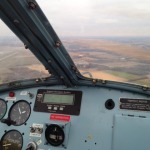
The airplane is easy to handle on the ground, with responsive but not “touchy” steering. In flight the stall is gentle, straight ahead with plenty of warning. It has good stability in pitch. You cannot appreciate this unless you have flown an aircraft for 10 plus hours in one day. It’s stability in roll is good, also allowing extended periods of hands off flight in fairly smooth air. Also the cockpit has ample room for two large people and one person can sit in it for hours on end with very little discomfort! The controls are light, and that combined with good stability in both pitch and roll makes it easy to fly for extended periods. One quality that especially endeared me to the Cygnet was its ability to take off at gross weight at temperatures above 90 degrees, the density altitude exceeded 4500 ft. several times and yet take off roll was not significantly longer, and when the airplane broke ground it climbed positively without the mushy feel common to other designs.
RECOGNITION………………….
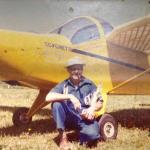
The first prototype, the Whistler SF-2, was awarded the “Outstanding Design Contribution” at the Oshkosh EAA convention in 1973. The design has been approved, made easier to build, made aerodynamically cleaner, and 50 lbs. lighter and in its present configuration, it is now known as the “Cygnet SF-2A”.

